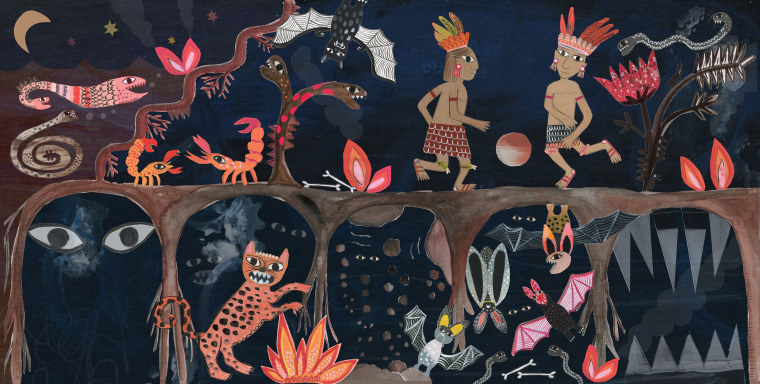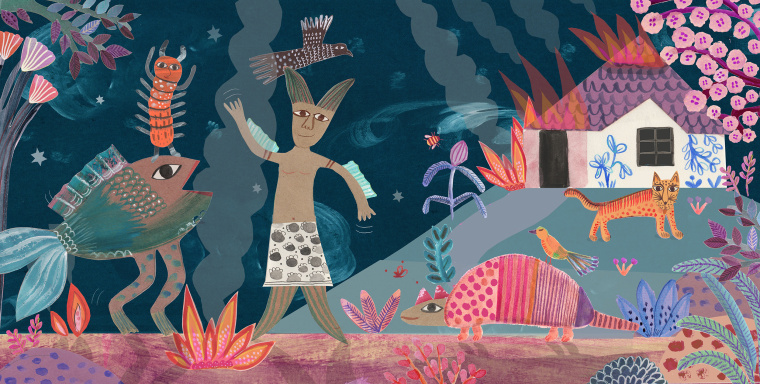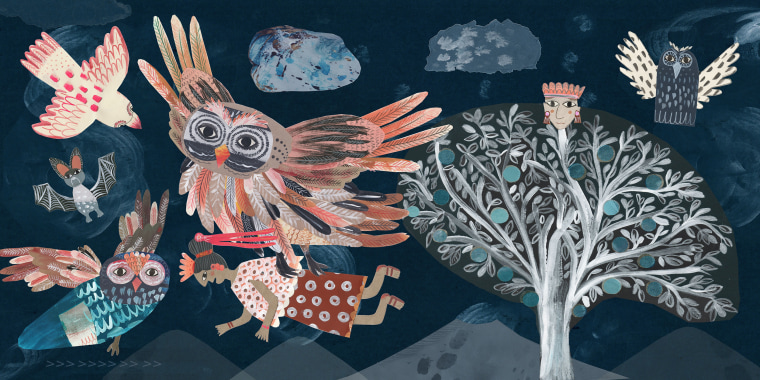Every culture has an origin story. Many Latinos can trace their cultural roots to an epic poem that was passed down in Central America for over a millennium — but this rich, important history has been largely buried, Mexican scholar Ilan Stavans says.
"The Popol Vuh in many ways is like 'Beowulf,' the Bible, the Viking sagas, 'The Iliad' and 'The Odyssey,'" says Stavans, a Latin American and Latino culture professor at Amherst College. "It tells stories of battles and the rise and fall of a people."
Stavans is the author of "Popol Vuh: A Retelling," a prose rendition of the heroic epic poem about the creation of the world as told by the K'iche' Maya people of Guatemala. The book, with stunning illustrations by the Salvadoran folk artist Gabriela Larios, is out Tuesday.
The Popol Vuh is considered one of the most important texts about the Mayans and the ancient history of the Americas. Although scholars acknowledge its significance and other versions of the book have been published, it's not commonly known.
"None of the indigenous narratives of the Americas have achieved canonical status worldwide. The disdain has to do with the allergy of Europe to nontraditional stories from outside the continent," Stavans says. "The Spanish Empire kept these narratives — the Popol Vuh is unquestionably the most important of them — from being recognized as legitimate. And Mexico and Central America haven't invested in them wholeheartedly, keeping them at best as museum artifacts."

It's believed that the sprawling epic was passed down orally for over a thousand years until it was first put in writing by K'iche' nobility around the 1550s, when they found themselves under the control of Spanish colonizers.
It was later translated into Spanish by the Dominican friar Francisco Ximénez at the beginning of the 18th century.
"The preservation of the Popol Vuh is a story about indigenous oppression, survival and endurance. But it also shows how colonizers can have within themselves the ability to rescue a culture, give voice to a people as an outsider," says Stavans, referring to Ximénez, who was, ironically, largely forgotten by history.
Stavans says that while the Popol Vuh celebrates the mythology and history of the K'iche' people in Mesoamerica — referring to the Maya cultures that lived in modern-day Mexico, Guatemala, Honduras, Belize, El Salvador and Costa Rica — the story behind its preservation is truly Latin American in scope, because it shows how indigenous peoples struggled to survive in the face of European colonization.
"Sunset has fallen on the K'iche' people. Our lands have been taken away, our leaders have been subjugated, our children have been stolen," Stavans writes at the beginning of the book. "I tell these stories of the ancient world to once again ignite our people's hearts."

Stavans' retelling of the Popol Vuh is divided into four parts. The first part focuses on the sacred Maya creation myth, which describes how the world was made and how humans were created after the gods experimented with other creatures. The second part tells the story of the hero twins Hunahpú and Xbalanqué, who take on the gods of the Maya underworld by playing a ballgame that Stavans compares to soccer. The third part describes the genealogy of the K'iche' nobility, and the fourth part concludes with the destruction of the K'iche' and the arrival of the Spaniards.
Classic literature fans might compare the Mayan underworld (known as Xibalba) with Dante's 14th century Italian epic "The Divine Comedy," which also gives readers an underground tour of hell.
Other fans might also find exciting parallels with more recent pop culture hits like Netflix's "Stranger Things." In the TV show, the Upside Down world is an alternate dimension full of death and monsters that is connected to the human world through a series of portals. And similarly, Xibalba is a place of death and fear that is connected to the living world through caves and cenotes.
For Stavans, the connection between opposing worlds — the living and the dead, good and evil, the seen and the unseen — challenges readers to have a deeper understanding of the complexity of reality.
"My mother told them to me, she got them from her own mother, and so on," the book says. "They explain how nature is ruled by opposites: truth and lies, light and darkness, sound and silence. Humans swing on a pendulum without ever becoming static."
Follow NBC Latino on Facebook, Twitter and Instagram.

